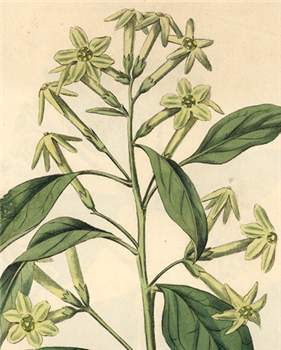Taxonomy
Cestrum L., Sp. Pl. 1: 191 (1753), & Gen. Pl. 5th edn, 88 (1754); name variously said to derive from the Greek kestron (a plant); or the Greek kestrum (an engraver's tool), in reference to the anther shape; or because of the supposed similarity to a plant of the same name described by Dioscorides.
Type species: C. nocturnum L.
Woody shrubs or small trees, glabrous, or pubescent with simple, forked or dendritic hairs. Leaves mostly alternate, sometimes paired, simple, entire, petiolate. Inflorescence usually raceme- or panicle-like, axillary or terminal. Flowers bisexual, sometimes slightly zygomorphic, often subtended by a small bract. Calyx tubular, 5–7–lobed. Corolla tubular or salver-shaped (not in Australia), variously coloured; tube often slightly inflated towards limb; limb shortly 5–7–lobed, the lobes valvate in bud. Stamens 5, equal or subequal, variously inserted on corolla-tube; anthers bilocular, versatile, dehiscing by longitudinal slits. Ovary bilocular; stigma capitate. Fruit a succulent berry. Seeds prismatic or ovoid.
A genus of c. 250 species, native to tropical Central and South America, with major concentrations in Brazil and the Andean region. Several species widely cultivated as ornamentals for their fragrant, often nocturnal flowers; the foliage on the other hand usually has an unpleasant smell when bruised and most of their parts are posisonous. Four species naturalised in Australia as garden escapes. P. Francey, Monographie du genre Cestrum L., Candollea 6: 46–398 (1935), 7: 1–132 (1936); D.E. Symon, The solanaceous genera, Browallia, Capsicum, Cestrum, Cyphomandra, Hyoscyamus, Lycopersicon, Nierembergia, Physalis, Petunia, Salpichroa and Withania, naturalised in Australia, J. Adelaide Bot. Gard. 3: 133–166 (1981).
Changes since the Flora of Australia treatment
Since this treatment, Cestrum fasciculatum has also become naturalised in Australia. This species and C. fasciculatum cv. Newellii, the latter thought to be a hybrid between C. fasciculatum and C. elegans, are difficult to distinguish from C. elegans.
Cestrum diurnum has not been recorded as naturalised in Australia to this time but it too has the potential to become a weed in Australia (see the Pacific Island Ecosystems at Risk site at www.hear.org/pier/species/cestrum_diurnum.htm the New York Botanical Garden site at http://207.156.243.8/emu/vh/narratives.php?irn=536 or http://commons.wikimedia.org/wiki/Image:Cestrum_diurnum_-_Day_cestrum.jpg for further links and photographs). Just how widely it is grown in Australian gardens is not known, but it should be easily distinguished by its white flowers which open during the day.
Reference
Nee, M. (2001). An overview of Cestrum. In R.G. van den Berg, G.W.M. Barendse, G.M. van der Weerden, & C. Mariani (eds). Solanaceae V: Advances in Taxonomy and Utilization. (Nijmegen University Press: Netherlands).
Key to species
1 Flowers orange to greenish-yellow; new growth sparsely pubescent or glabrescent; berry white or black when mature
2 Corolla orange-yellow; leaves elliptic to broadly elliptic; berry white when mature
Cestrum aurantiacum
2: Corolla greenish-yellow; leaves narrowly elliptic to lanceolate; berry black or white when mature
3 Corolla-tube 2–3 mm wide at apex; filaments with an erect process; berry white when mature
Cestrum nocturnum
3: Corolla-tube 3–5 mm wide at apex; filaments without an erect process; berry black when mature
Cestrum parqui
1: Flowers reddish
4 Calyx and corolla externally glabrous
Cestrum elegans
4 Calyx and corolla externally pubescent
Cestrum fasciculatum
[Key modified from Flora of Australia (1982) to include C. fasciculatum. rmb]


